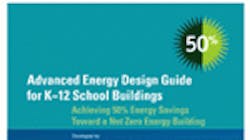The Advanced Energy Design Guide (AEDG) was written by a group of leading building industry organizations, and is now being made available to hospitals in the U.S. The AEDG for Large Hospitals is the fourth in the series, designed to provide recommendations for achieving 50% energy savings when compared with the minimum code requirements of ANSI/ASHRAE/IESNA Standard 90.1-2004, Energy Standard for Buildings Except Low-Rise Residential Buildings.
The book was developed by a committee representing a diverse group of energy professionals drawn from ASHRAE, the American Institute of Architects (AIA), the Illuminating Engineering Society (IES), the Department of Energy (DOE) and the United States Green Building Council (USGBC).
“Most important in the Advanced Energy Design Guide for Large Hospitals is the recognition that patient outcomes, safety and experience trump all cost- and energy-saving strategies,” Shanti Pless, chair of committee that wrote the guide, said. “However, a well designed, constructed, operated and maintained facility is a major contributor to the environment of care and can improve patient outcomes, safety and comfort.”
The Guide focuses on standard mid-to-large-size hospitals that would typically be at least 100,000 sq.ft. in size, but the strategies apply to all sizes and classifications of large hospitals. Space types covered include conference, lobby, lounge and office areas; reception/waiting areas and examination and treatment rooms; clean and soiled workrooms; nurse stations, nurseries, patient rooms; operating rooms, procedure rooms, recovery rooms and sterilizer equipment areas; pharmacies and laboratories; triage, trauma and emergency rooms; physical therapy and radiology/imaging rooms; and storage, receiving and mechanical/electrical/telecom rooms.
Included in the Guide are recommendations for the design of the building opaque envelope; fenestration; lighting systems; HVAC systems; building automation and controls; outdoor air requirements; service water heating; measurement and verification; and plug and process loads, including kitchen equipment.
Along with whole building and technology case studies, the Guide highlights that existing reliable technologies and design philosophies can be used to reduce energy, according to Pless.
Some of the technologies and philosophies highlighted in the book include:
• Use of shape and form to give access to daylighting in spaces that usually have no windows
• Daylighting of staff areas and publics spaces while at the same time specifying proper glazing to control solar gain
• Elimination of reheat, which is the largest energy saver from the HVAC system. Other HVAC savings comes from the de-coupling of ventilation air treatment and space conditioning and the elimination of steam boilers
• Recommendations to reduce and control plug and process loads. including commercial kitchen equipment
• Reductions in interior and exterior lighting
• Recommendations involving LED surgery lights, which have the added benefit of allowing surgeons to set the thermostat higher in the operating rooms
• Measurement and verification recommendations to demonstrate savings are being realized with the added benefit of helping solve operational issues.
The 50% Advanced Energy Design Guide series follows an earlier series that provided guidance to achieve 30% savings. The ultimate goal is to provide guidance to achieve net zero energy buildings; that is, buildings that, on an annual basis, produce more energy than they consume. Other books in the 50% savings series deal small to medium office buildings, K-12 schools and medium to big box retail buildings. Since the Guides first began to be offered as free downloads at the beginning of 2008, more than 400,000 have been downloaded.
